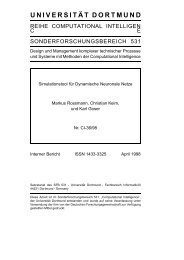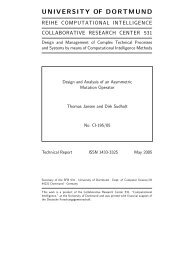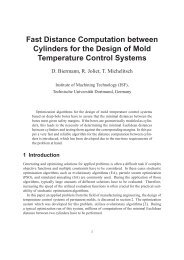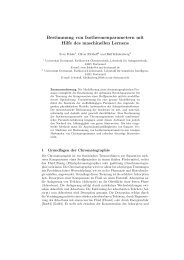Self-Adaptive Genetic Algorithms with Simulated Binary Crossover
Self-Adaptive Genetic Algorithms with Simulated Binary Crossover
Self-Adaptive Genetic Algorithms with Simulated Binary Crossover
You also want an ePaper? Increase the reach of your titles
YUMPU automatically turns print PDFs into web optimized ePapers that Google loves.
Population-best distance from optima, R<br />
1<br />
epsilon = 10^(-15)<br />
epsilon = 10^(-5) epsilon = 10^(-10)<br />
1e-10<br />
1e-10<br />
range[?1:0;1:0]<br />
1e-20<br />
1e-20<br />
0 500 1000 1500 2000<br />
0 500 1000 1500 2000<br />
Generation number<br />
Generation number<br />
Figure 5: Population-best distance from optimum Figure 6: Population standard deviation <strong>with</strong> gen-<br />
(R) for populations initialized at different ranges eration number for populations initialized at dif- [10?;10+]for the function F1-2.<br />
ferent ranges[10?;10+]for the function F1-2.<br />
5.1.3 Function F1-3: Time-varying function<br />
In order to investigate the performance of real-parameter GAs <strong>with</strong> SBX on time-varying functions, we<br />
now choose the same function as F1-1, butxinow varies <strong>with</strong> generation number in the<br />
Population standard deviation<br />
1<br />
epsilon = 10^(-5)<br />
epsilon = 10^(-15)<br />
epsilon = 10^(-10)<br />
at random. The optimum is changed after every 1,000 generations so that at the time of a change in<br />
the optimum the population diversity has reduced substantially. The best function value and average<br />
population standard deviation (as defined earlier) in all variables are plotted versus generation number in<br />
Figure 7. GA parameter settings same as that in F1-1 are used here. The figure shows that even though all<br />
Population statistics<br />
1e+10<br />
1<br />
1e-10<br />
Best function value<br />
Standard deviation in variables<br />
1e-20<br />
0 500 1000 1500 2000 2500<br />
Generation number<br />
3000 3500 4000<br />
Figure 7: Population-best function value and average of population standard deviation in variables are<br />
shown <strong>with</strong> generation number, as test function F1-3 changes its optimum after every 1,000 generations.<br />
population members are all <strong>with</strong>in a small range (in the order of10?10) at the end of 999 generations, the<br />
population <strong>with</strong> SBX operator can diverge and can get adapted to a changed optimum. This happens not<br />
only once, but as many times as there is a change in the function.<br />
11








